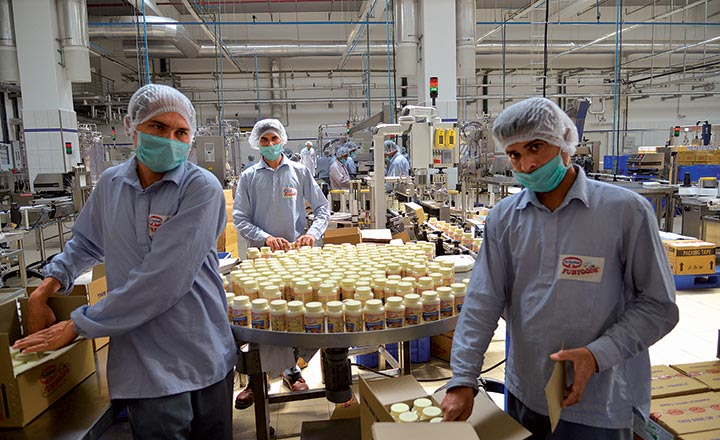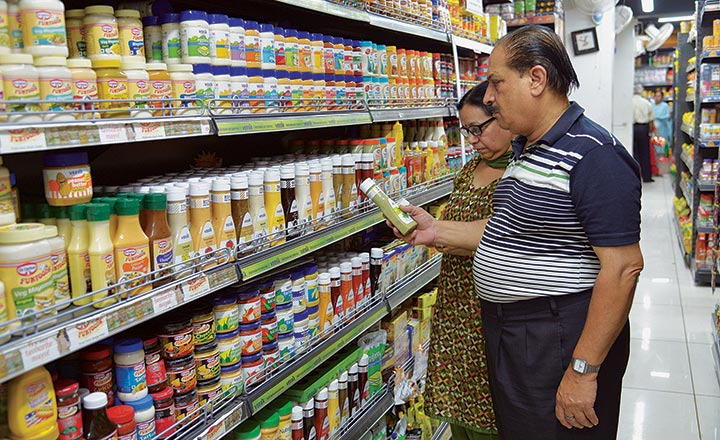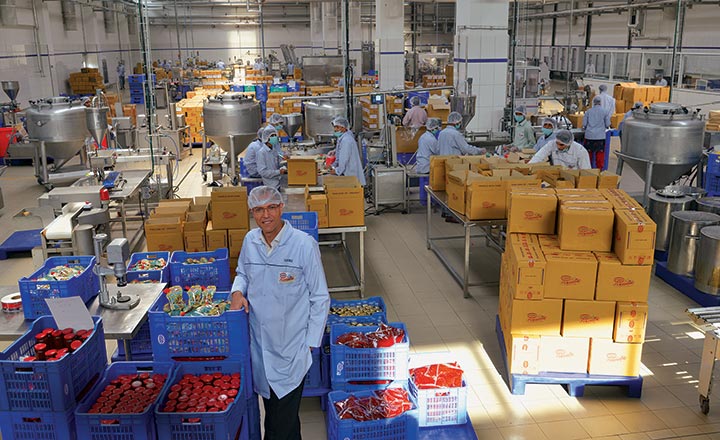That sweet aroma of milkshake powder, the not-so-tangy whiff of mayonnaise — there’s something new for the olfactory senses at every turn one takes inside Dr. Oetker’s manufacturing facility in Kaharani, Rajasthan. Spanning across 50,000 sq ft, the plant, which commenced operations last year, stands central to the growth plans of the decade-old Indian subsidiary of its German parent that’s worth €6.2 billion. The market leader in mayonnaise seems to have finally hit the bullseye when it comes to identifying the preferences of the Indian palate. But, that came only after persistent effort.
Finding the right flavour
When Dr. Oetker came to India in 2007, it walked into the country confidently having tasted success in the European and Australian markets. The company, which makes baking powder, cake mixes, frozen pizzas, etc. entered the Indian market with most of its offerings. It only took a while for the company to realise its folly. “I’m 50-years-old now. And I have lived in the US, UK, Italy, Switzerland, Poland, Germany and Austria. But when you come to India you can throw all that know-how in the garbage can. None of what works around the world works here,” laughs Oliver Mirza, managing director, Dr. Oetker India.
The company initially imported products such as frozen pizzas and muesli and locally manufactured a few other products such as vanilla milkshake powder — all of which were its top selling products globally. But, all of these remained untouched on Indian shelves. “When I saw that the vanilla milkshake powder, which is usually a top seller across the world, was not selling here, I thought it is because nobody can see there is vanilla in there,” Mirza recalls. In its other markets, the powder was packaged in a way that the consumers could see real bits of vanilla inside the powder. So Mirza decided to replicate it here. “I thought the product will fly off shelves. Instead, I killed the product”. He simply could not understand what had gone wrong until he received complaints from consumers who mistook the bits for dirt.
Imported products, too, faced a similar challenge. The company launched its muesli brand Vitalis in India the same way it was marketed in Europe, without writing ‘muesli’ explicitly on the packet. Being a staple breakfast item, it worked there, but not in India. So Mirza introduced labelled packets but the product still remained untouched. Due to the European recipe — which contains chocolate with a melting point of 26-270C and honey that turned gooey in the tropical Indian weather — the product didn’t look good when the customer opened the box. As for frozen pizzas, it was cold-shouldered in India as people did not have ovens and unlike Europe, the country didn’t have a baking culture.
Apart from products, managing the entire set-up including distribution and even the kirana shops posed a challenge. For the first time Dr. Oetker saw its products being rejected by shopkeepers for the ingredients. For example, Jain shopkeepers rejected products containing garlic and onion. The only way forward for the company was to start from scratch or in Mirza’s words, “to treat India as a different planet.” He further explains, “We experimented a lot, but we felt it made no sense. So, we focused on finding an acquisition.” In December 2008, the company acquired Fun Foods — a local brand that made western sauces, masala mixes and chutneys. It even made private labels for the likes of Walmart and catered to QSR chains. Those weren’t core products for Dr. Oetker, whose global focus was on baking-related foods. But with those being irrelevant in the Indian market, the only choice was to adapt. The retail sales of Fun Foods then stood at Rs.130 million and the company was acquired for Rs.1.10 billion. To build a brand name, Dr. Oetker adopted an umbrella strategy where it started building Fun Foods as a sub-brand and placed its own logo on top as a parent brand. It also focused more on retail than QSR services. With Fun Foods being spread across 125 cities then, the acquisition gave Dr. Oetker a pan-India presence.
The first product to be launched under the brand was olive oil mayo, which got a lukewarm response due to its high price point. “We underestimated the focus on price points and the value-for-money factor in India. So, we increased the olive oil content in the product and relaunched it.” And that seemed to have done the trick. But it didn’t stop there and introduced mayo in different variants for the Indian taste buds with flavours such as mint, garlic and tandoori.
Dr. Oetker India has since seen steady growth and touched a revenue of Rs.2 billion in FY17. Expecting to see a topline of Rs.2.5 billion in FY18, it is today the market leader in western sauces with a 70% share in mayonnaise, 40% in peanut butter and 47% in pasta sauce. India is a relatively small market, but the fastest growing one for the company today with 30% organic growth in the past few years.

Staking claim
Mayonnaise is the largest consumed condiment globally with a market size of $12 billion as against the $4-billion ketchup market. But in India the latter rules the roost with a market of Rs.12 billion. When Dr. Oetker entered India, the mayonnaise market was just 1/10th of the ketchup market, which meant that if the company wanted to sell its products, it had to educate the customer first. Familiarising people with peanut butter and pasta sauce proved to be easy, but mayonnaise remained a challenge as the product name wasn’t self-explanatory and people did not know how to use it.
Some advertisers suggested trying small Rs.10 sachets, but Mirza wasn’t keen on it. He felt that if mayo was bigger than ketchup across the world, then it should at least have an equal market in India. He also ruled out plans to enter the ketchup segment. “In ketchup, we had no opportunity to differentiate ourselves from competitors because there are already enough players in the market. We would only enter a market if we could be number one in a few years. If we don’t see that opportunity, it doesn’t make sense to us,” he affirms. Initial investments in the Indian market were directed towards educational promotions, exhibitions, food show sponsorships, recipe brochures and videos. “The key is to make people aware about mayonnaise and to teach them how to use it. It was 1/10th the market. Today, it has become 1/7th and 1/6th in certain areas. We started marketing it as a spread and a base ingredient. If it is known as a dip, it will remain just that and it’s very difficult to then get customers to try something more with it,” Mirza says in a convincing sales pitch.
For advertising alone, the company spent around Rs.200 million per annum. In order to adapt to the largely vegetarian market, the company introduced eggless mayonnaise, which was later rebranded as vegetarian mayonnaise. “When we tested a TV spot, we found that people still feared it might contain gelatin or some other sort of non-vegetarian ingredient. So we reintroduced it as veg mayonnaise. The competition has not copied us so far and we are happy about that,” says the relieved country head.
Towards the end of 2015 it roped in Bollywood actress Sonali Bendre for its TV campaign, which targeted nuclear families and urban Indian working mothers. Anil Shah, a distributor of Dr. Oetker in Mumbai, has seen a spike in sales ever since the campaign. According to him,“Dr. Oetker started advertising in 2015 and became the first brand to do so in the mayonnaise category. Since then, I have seen an incredible growth in the category. The placement in outlets has also gone up in addition to an increase in the number of stores.” Mirza estimates the current mayo market in India to be around Rs.2 billion-2.5 billion. He aims to take it to Rs.10 billion and increase the number of his consumers from 10 million to 35 million by mid-2020.

Chhota packet, bada dhamaka
Dr. Oetker currently has a presence in 489 Indian cities and about 50% of its business is generated by the top 10 metros. The rest comes from the 479 small towns, which would be key to achieving its Rs.10-billion target. For this, it has created small-sized packets of 100 gm priced at Rs.35. “We intend to focus more on educating the customer in smaller cities such as Ratnagiri, Surat and Baroda,” Mirza says. And he is confident that smaller packs would be key to this. “Why would you buy an 850-gm pack if you don’t know what to do with it? It’s like trying to get a German to buy a big jar of chutney. It’s not about the purchasing power, it’s about product awareness. In metros our efforts are aimed at increasing household consumption, whereas in small towns the aim is to reach more consumers, which is easier with a 100-gm pack.”
Shah seconds this. “The launch of the chhotu (small) packs have helped grow the category. Many people who started consuming the smaller packs have now moved to bigger packs,” he says. The company currently claims to see strong growth from the small packs across four products — burger mayonnaise, pizza toppings, zero-fat mayo and classic veg mayo. Depending on the success of the small packs, Mirza plans to launch a few more products in the future without burdening the retailer for space. “We believe that the 100-gm pack is a key item for growth. We have ordered a machine to produce these, which is arriving in a few weeks. We are all geared up for it,” says an enthusiastic Mirza.
While earlier reports hinted at the company’s plans to re-enter the muesli segment by producing in India, Mirza rules it out for now. The company has the machinery and necessary infrastructure, but a global change in strategy to not focus on muesli stopped it from trying out the product again in India. “We are still discussing it. We have the infrastructure and are capable of making muesli that remains crunchy in hot milk. But we have to align with our global strategy. So, we might produce it for the export market but not for the Indian market at the moment,” he says. The company, however, plans to bring back frozen pizza, but not for retail. “Baking is still not part of the culture here. So, we will introduce it for the HoReCa (Hotels, restaurants and catering) segment and for airlines,” he adds.
While the major focus of the company has been on retail since its entry in India, it recently started paying more attention to QSR and HoReCa channels by setting up a dedicated team for both. With the B2B segment contributing about 20% to its business, Dr. Oetker has some leading names such as Domino’s, KFC and Burger King on its client list. The company collaborates with clients to introduce new products and constantly innovates to meet their needs. Mirza has learnt that innovation is key to success in the HoReCa sector where the same product would put off consumers over time. “In QSR they always need something that prevents you from getting bored. So, we always work with them to bring out new products. If you have had the cheese burst pizza introduced by Domino’s, you can see a layer of cheese on the top and another liquid form of cheese inside the pizza. The latter is not cheese, but a product named cheese mayonnaise introduced by us to meet that particular need,” reveals Mirza. He also cites the example of the double trouble burger launched by KFC in collaboration with the company. It has also relaunched its food service as Dr. Oetker Professional.
Building up an appetite
In 2016, after spending eight years in the market and operating out of three rented units, Dr. Oetker invested Rs.2.9 billion to set up a new facility that began operations in 2017. The plant boasts of a capacity of 25,000 tonne, which can scale up to 50,000 tonne and can cater to 100,000 tonne after expansion within the existing premises and is the biggest unit in Asia, Australia and Africa. The plant will also cater to its international markets along with the local market. Dr. Oetker started exporting the products made in the Indian plant to Malaysia in December last year. “It’s not like we are looking outside India because there’s no growth here. We are building up that market, but we are also going a little beyond that. We will look at Nepal in the coming months,” says Mirza, whose plans include future exports to SAARC countries.
The plant currently manufactures emulsified, pasteurised and sterilised sauces, powders and syrups. Mirza adds that the company has a long-term plan in India and a vision to scale up by taking its workers along. “We have introduced a lot of automation, but we haven’t knocked off anyone from the payroll.” The company expects to turn profitable by the end of 2019. While Mirza is targeting Rs.5 billion for the Fun Foods business by 2020, he estimates another Rs.5 billion to kick in from exports, acquisitions, experiments with frozen pizza and food services.
Hamish Kazi is another distributor for Dr. Oetker India in the suburban Mumbai belt of Bandra-Vile Parle. Since 2013, he has seen a surge in demand for its products and feels that none of its competitors are trying to grow their market like the company. “The mayonnaise market is currently small but the opportunity is huge. Other brands are just trying to take away market share from them and do not care about growing the category. But Dr. Oetker is the only one focused on growing the market pie,” he adds.
A 70% market share is huge, but do players such as Veeba worry Dr. Oetker India? Mirza remains unfazed by competition. He predicts that by 2020 the mayonnaise market share would drop to about 50%. “Market share is critical in saturated markets. But in markets that are still developing, focusing on overall market share is being short-sighted. We love competition as long as it expands the market. It is only logical that our overall share might drop as newer people come in. But our destiny is defined by what we do and not by what others do,” Mirza exclaims.











